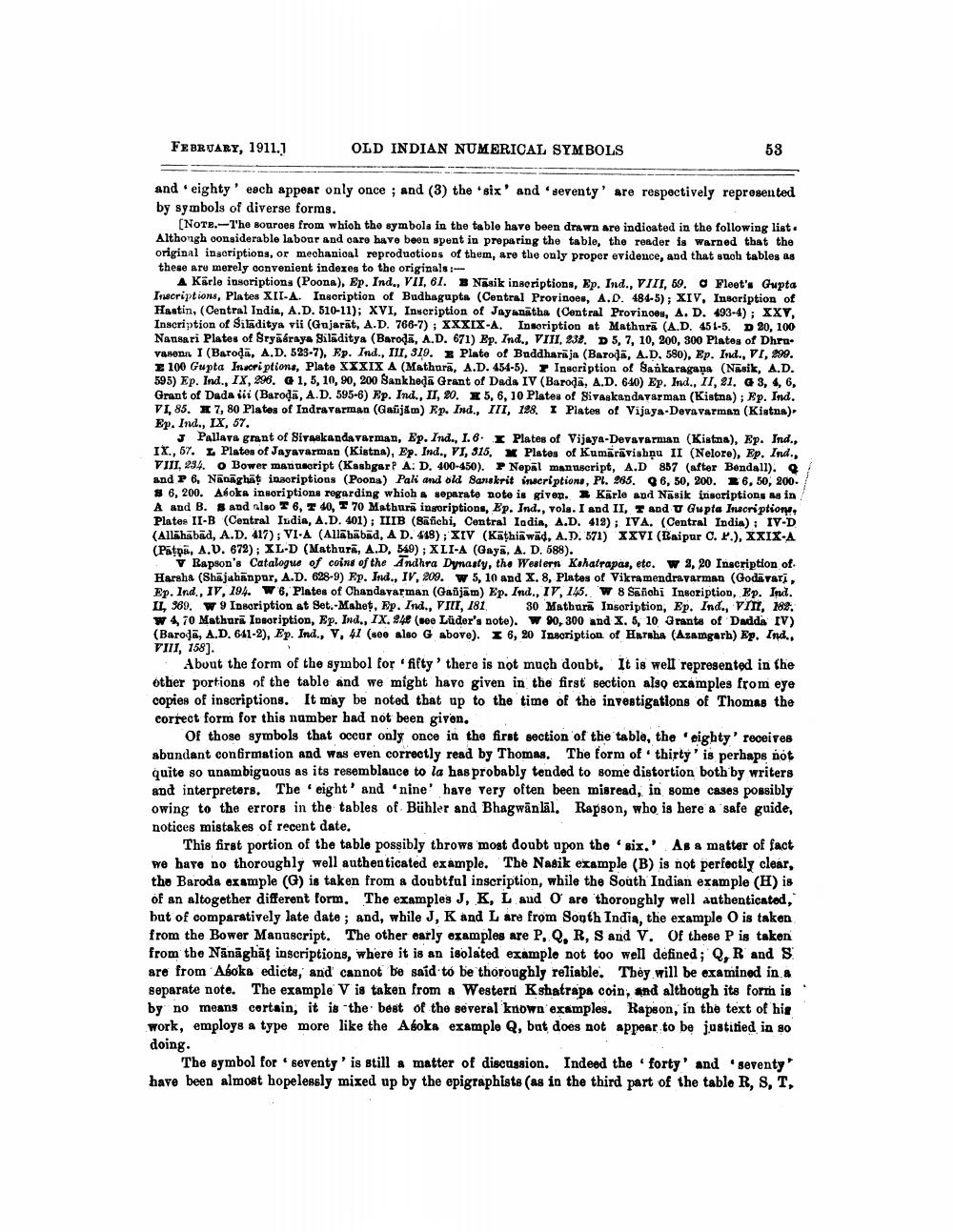________________
FEBRUARY, 1911.)
OLD INDIAN NUMERICAL SYMBOLS
53
and eighty' esch appear only once ; and (3) the six' and seventy' are respectively represented by symbols of diverse forms.
(NOTA.-The sources from which the symbols in the table have been drawn are indicated in the following list. Although considerable labour and oare have been spent in preparing the table, the reader is warned that the original inscriptions, or mechanioal reproductions of them, are the only proper evidence, and that such tables as these are merely convenient indexes to the originals
A Kirlo insoriptions (Poona), Ep. Ind., VII, 61. B Nasik inseriptions, Ep. Ind., VIII, 59. O Fleet's Gupta Iwweriptions, Plates XII-A. Inscription of Budhagupts (Central Provinces, A.D. 484-5); XIV, Inscription of Hastin, (Central India, A.D. 510-11); XVI, Inscription of Jayantha (Central Provinces, A.D. 193-4); XXV, Inscription of Siladitya vii (Gujarät, A.D. 766-7) ; XXXIX-A. Insoription at Mathura (A.D. 451-5. D 20, 100 Nansari Plates of Sryakraya Siladitya (Baroda, A.D. 671) Ep. Ind.. VIII. 234, D5, 7, 10, 200, 300 Plates of Dhrge vasenn. I (Baroda, A.D. 523-7), Ep. Ind., III, 319. Plate of Buddharaja (Baroda, A.D. 580). Ep. Ind., VI, 299. E 100 Gupta Inscriptions, Plato XXXIX A (Mathura, A.D. 434-5). 7 Inscription of Bankaragana (Nasik, A.D. 595) Ep. Ind., IX, 296. 61, 5, 10, 90, 200 Bankheda Grant of Dada IV (Baroda, A.D. 640) Ep. Ind., II, 81. & 3, 4, 6, Grant of Dada ji (Baroda, A.D. 595-6) Ep. Ind., II, 20. X 5, 6, 10 Plates of Bivakandavarman (Kistna); Rp. Ind. VI, 85. X 7, 80 Plates of Indravarman (Galjim) Rp. Ind., III, 198. I Plates of Vijaya-Deva varman (Kistna) Ep. Ind., IX, 57.
Pallava gant of Sivakanda varman, Ep. Ind., 1.8. Plates of Vijaya-Devararman (Kistna), Ep. Ind., IX., 57. L Plates of Jayavarman (Kistna), Ep. Ind., VI, 515, x Plates of Kumäravisbņu II (Nelore), Ep. Ind. VIII, 234. Bower mantsoript (KasbgarA: D. 400-450). P Nepal manuscript, A.D 857 (after Bendall). and P6, Nanāghat inariptions (Poona) Pali and old Sanskrit inscriptions, Pl. 265. 96, 50, 200. 26,50, 200. $ 6, 200. Aloka insoriptions regarding which separate note is given. . Kirlo and Nasik insoriptions as in A and B. and also T 6, T10, T70 Mathurs insoriptions, Ep. Ind., vols. I and II, T and U Gupta Inuoription Plates II-B (Central India, A.D. 401); IIIB (Bañchi, Central India, A.D. 419): IVA. (Central India); IV-D (Allāhābād, A.D. 417); VI-A (Allahabad, A D. 418) ; XIV (Kathiawad, A.D. 571) XXVI (Raipur C. P.), XXIX-A (Patpa, A.V. 672): XL-D (Mathura, A.D. 549) ; XLI-A (Gaya, A. D. 588).
v Rapson's Catalogue of coins of the Andhra Dynasty, the Western Kshatrapas, etc. W 2, 20 Inscription of Harsha (Shajahiinpor, A.D. 628-9) Ep. Ind., IV, 209. w 5, 10 and X. 8, Plates of Vikramendravarman (Godavari, Ep. Ind., IV, 194. W 6, Plates of Chandavarman (Gaðjām) Ep. Ind., IV, 145. W 8 Sailohi Inscription, Kp. Inul. IL 500 W 9 Insoription at Bot. Mahet, Ep. Ind., VIII, 181 80 Mathuri Insoription. Ep. Ind.. VII. 188. w 4,70 Mathura osoription, Ep. Ind., IX. 84€ (see Lüder's note). W 90, 300 and X. , 10 Grants of Dadda IV) (Baroda, A.D. 641-2), Ep. Ind., V, 41 (500 also G above). I 6, 20 Inaoription of Harsha (Azamgarh) Ep. Ind.. VIII, 158].
About the form of the symbol for 'fifty' there is not much doubt. It is well represented in the other portions of the table and we might have given in the first section also examples from eye copies of inscriptions. It may be noted that up to the time of the investigations of Thomas the correct form for this number bad not been given.
of those symbols that occur only once in the first section of the table, the eighty' receives abundant confirmation and was even correctly read by Thomas. The form of thirty' is perhaps not quite so unambiguous as its resemblance to la has probably tended to some distortion both by writers and interpreters. The eight' and 'nine' have very often been misread, in some cases possibly owing to the errors in the tables of Bühler and Bhagwānlāl. Rapson, who is here a safe guide, notices mistakes of recent date.
This first portion of the table possibly throws most doubt upon the six.' As a matter of fact we have do thoroughly well authenticated example. The Nasik example (B) is not perfectly clear, the Baroda example (G) is taken from a doubtful inscription, while the South Indian example (H) is of an altogether different form. The examples J, K, L and are thoroughly well authenticated, but of comparatively late date; and, while J, K and L are from Sooth India, the example is taken from the Bower Manuscript. The other early examples are P, Q, R, S and V. Of those P is taken from the Nānāghāt inscriptions, where it is an isolated example not too well defined ; Q, R and S are from Aboka edicts, and cannot be said to be thoroughly reliable. They will be examined in a separate note. The example V is taken from a Western Kshatrapa coin, and although its form is by no means cortain, it is the best of the several known examples. Rapson, in the text of hig work, employs a type more like the Asoka example Q, bat does not appear to be justified in 80 doing.
The symbol for seventy is still a matter of discussion. Indeed the forty' and seventy" have been almost hopelessly mixed up by the epigraphists (as in the third part of the table R, S, T,




